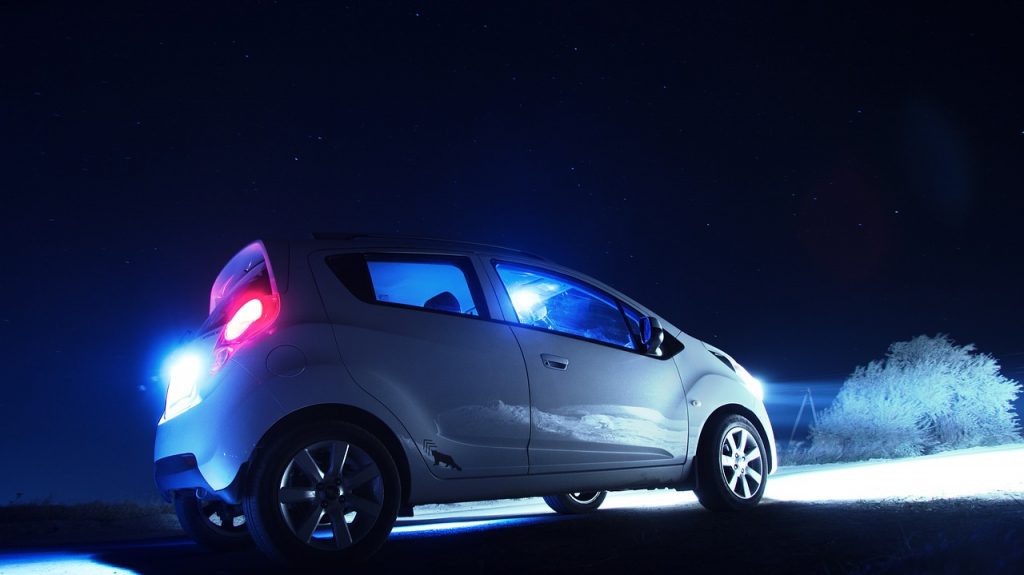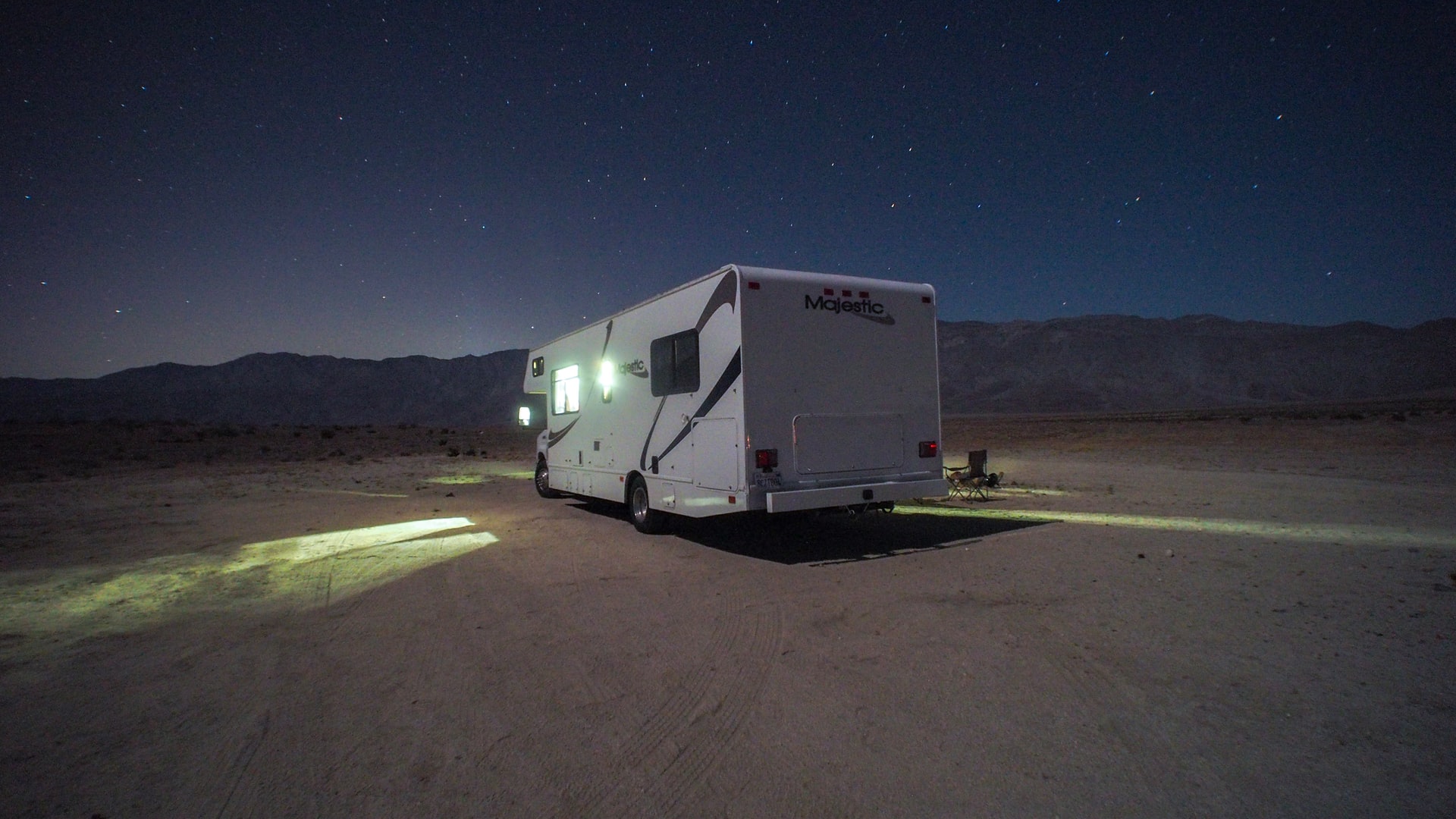It’s a question that drives you nuts. HID vs. LED headlights. Which should you put on your RV?
Have you noticed how some vehicles blind you with brilliant light as they approach and yet others don’t? It’s not only high beams that will dazzle your eyes.
In the HID vs. LED headlights debate, people forget one thing: other drivers.
You see, both HID and LED headlights are brighter than regular halogen bulbs. But it’s HID headlights that will blind oncoming traffic.
Okay, both of them are pretty bright. But where LED tends to glow, HID saturates the area with brilliant bluish light. And that may be great for the driver of the vehicle with the HID lights, but it’s awful for all the other drivers on the road.
And as you know, safe driving requires every driver to work together with every other driver around them. HID headlights don’t play that nice with others.
So why are HID lights so bright?
And in the HID vs. LED headlights battle, which one should you put on your RV?
Are you ready?
Because we’re just going to dive right in.
HID vs. LED Headlights
Let’s start with some basic concepts.
When deciding between HID vs. LED headlights, it’s important to understand the difference between them.
HID stands for “high-Intensity discharge.”
Get this.
HID bulbs are made up of gas inside a small quartz tube. Two electrodes flank the tube and pass an electrical current through the gas. The gas reacts and creates a highly concentrated arc of brilliant white light.
Cool!
On the other hand, light-emitting diodes (LEDs) are much simpler. It’s similar to your standard light bulb.
When the plastic bulb is connected to a power source (for example, the socket), a small chip inside the bulb attracts both positive and negative electrons which collide and radiate light photons. That’s why LED lights have more of a “glow” than the massive bright arc of HID headlights.
How do these differences affect driving?
The HID headlight is going to give you a much greater range and more illumination. That’s great for you, but on the other hand, it can also temporarily blind oncoming drivers, which is bad for everybody. So which is better when comparing HID vs. LED headlights?
Let’s get to it.

About high-intensity discharge (HID) lights
Did you know HID headlights are more commonly known as Xenon headlights?
It’s true!
That’s thanks to the chemical found in the gas that they use to create that brilliant blue-white arc of light.
And get this.
HID lights, or high-intensity discharge lights, are rare on RVs. In fact, very few manufacturers install them on any vehicle, and most of the time they’re after-market installs.
And that goes a long way to explaining why some vehicles just blind all the other drivers on the road.
You see, HID lightbulbs come in different sizes and intensities. A major factor to how bright lights actually appear on the road has to do with the reflective housing the lightbulb is placed in.
If someone installs an extremely bright HID bulb in a super reflective housing on their tiny Honda Civic, then they’re going to blind all the other drivers. On the other hand, an 18-wheeler tractor-trailer with professionally installed HID lights geared to the truck’s size and housing won’t.
Get it?
The US Department of Transportation has regulations in place which govern how bright headlights can be. Unfortunately, it’s nearly impossible to police.
Think about it.
How many police officers know anything about lumens and nits, and can accurately measure the light emitted from a headlight? On the other hand, if a Xenon light is installed properly in the right vehicle, then it can be beneficial to the driver.
We’re talking about a greater spectrum of light, leading to better visibility at longer ranges.
HID pros
- Great spectrum range
- Amazing illumination
- Lights up the road far ahead
HID cons
- Expensive
- Blinds other drivers
- Illegal in some jurisdictions
- Expensive
- Die out quickly
As you can see, while HID lights provide awesome illumination for the driver that has them, they’re not great for other cars on the road, and they don’t tend to last that long when compared with both LED and regular halogen bulbs.
Taken together, the cons quickly pile up. Things don’t look that good for Xenon in our HID vs. LED headlights showdown.
So, how what about LED headlights?
About light-emitting diode (LED) headlights
Okay, get this.
LED lights are softer than HID lights, as you know. In fact, LED lights are closer to natural light than any other artificial light source. That means softer hues, which means less strain on the eyes.
And you know what else?
Because of their unique technology, LED lights can be arranged in all sorts of different ways.
RELATED READS: Best LED Headlights for RVs
For starters, each LED bulb is very small. So you can buy them clustered together in different shapes, and you can find LED units that fit pretty much any vehicle. That includes your RV.
But there’s more.
You see, LED lights last a long time. Because they hardly use any energy, they can last for years upon years. We’re talking outlasting the life of your car, which is great for your wallet and the environment.
The only downside with LED lighting is the heat. These little lights get real hot real fast, so the housing needs to have proper ventilation to let heat escape.
Otherwise, you’re looking at foggy lights or even blown bulbs.
Pros
- Versatile
- Natural light
- Doesn’t blind other drivers
- Long-lasting
- Economical
- Environmentally-friendly
Cons
- Heat up very fast
- More expensive than both HID and halogen lights
There really aren’t that many cons to LED lights, which is why when it comes to choosing HID vs. LED headlights, we always suggest LED. At the end of the day, these are just better headlights for everyone.
That includes the other drivers around you.
And in case you’re worried that a softer light means you can’t see as well, don’t.
Because you can get as many lumens out of LED lights as you can out of HID lights — and without all that obnoxious glare. LED lights are just superior.

The bulb reigns supreme
So now you know that we have a winner when comparing HID vs. LED headlights.
However, that’s not the whole story.
For starters, why do people keep putting those darn HID lights on their vehicles?
Well, most of the time you’ll find it’s a young guy in a souped-up economy car or someone in a pickup truck who doesn’t really know what he’s doing. Any responsible adult who knows what they’re doing with their vehicle knows to steer clear of HID bulbs.
Go with LED, because they’re better than HID.
The Benefits of LED over HID
You’re probably not completely convinced that LED is superior to HID. And to be fair, there are some things HID does better than LID.
For instance, if you want to send a Morse code signal to an orbiting space station, HID is the way to go.
But aside from lighting up the atmosphere and blinding every driver and pilot around, LED provides so much more. Did you know that LED lights are the most durable type of light on the planet?
Whether you install LED lights inside your RV for nice interior lighting, or you kit out your headlights with LED bulbs, these things are going to last. And they can take a beating, too. You see, with regular halogen bulbs, the oils your fingers leave behind will superheat and the bulb can explode.
Not so with LED lights.
But there is so much more than LED lights have going for them. Check it out.
Ba-bam!
When you turn on HID lights, they can take a few minutes to reach full brightness. That’s thanks to the need for each atom inside the gas to become energized. They won’t produce radiation until then, and it’s a chain reaction, so you need to wait for every atom to be fully engaged before you get full brightness.
No so with LED lights. When you turn on LED lights…
BOOM!
Instant light. There’s no waiting around for your headlights to power up.
Don’t blind me
HID vs. LED headlights isn’t a competition at all, really.
That’s partially because LED lights have much less ambient glare than HID lights. LEDs light up the road and surroundings with a natural glow so that other drivers can function normally.
Think of how a candle lights up a room, but you can look at a candle without going blind. Now compare that to flicking on the bathroom light at three in the morning after you’ve been asleep for a few hours.
You get the idea.
HID blasts everything in front of it with a massive amount of light. LED just does lighting better.
The clincher
It’s not often that you think of energy efficiency when it comes to your vehicle’s lighting.
After all, so long as you have a good alternator, your battery should last years, right? Well, there’s more to the story than just the cost of a battery (although that is part of it).
Get this.
The more energy-intensive the light bulb, the shorter its life. That means those HID bulbs burn out really fast. Even old-fashioned halogen bulbs last longer, and they don’t cost half as much.
LED bulbs, on the other hand, can last up to 25 years. Of course, the bulbs in a headlight probably won’t last that long, but the chances are that when the vehicle finally kicks the bucket, those LED lights will still be going. And you know what that means?
That means you didn’t have to spend money replacing headlights. Also, you didn’t have to put multiple bulbs in a landfill.
And that’s thanks to energy efficiency.

Looks matter
Finally, when comparing HID vs. LED headlights, you’ll find that LED bulbs are more aesthetic.
Seriously.
That beautiful natural glow coming from the front of your car illuminates the road and the sides of the road so you can see perfectly, but you don’t have to squint.
If you’re on a long night drive, and let’s face it, that happens in an RV more than in a car, then your eyes will appreciate the LED. They won’t tire as much.
You’ll also get less glare off wet roads, and more importantly, oncoming traffic won’t be blinded by your headlights. Neither will the drivers of the cars in front of you. It’s an all-around more pleasing light.
How to Install LED Headlights
In the HID vs. LED headlights battle, we know that LED lights are the ones you want.
Before you install LED headlights in your RV, you first need to do a bit of Googling (or check your owner’s manual) to find out the proper procedures for your specific vehicle make and model.
That said, most RVs follow the same fundamental principles. If you have a generator slide, it will be a lot easier.
The light bulbs themselves are extremely easy to replace.
Let’s get to it.
Buy this first
Of course, comparing HID vs. LED headlights means nothing if you don’t have either of them.
The first thing you’ll want to do is purchase an LED headlight kit. These are relatively inexpensive and easy to find. The only problem is that you need to know what size headlight your RV takes. We don’t know that, so you’ll have to dig that information up yourself.
But once you do find it, the next thing you want to do is buy LED lights.
One such headlight is the Alla Lighting S-HCR 2018 H11 LED headlight bulb.
These are high-powered 10,000-lumen bulbs that fit most vehicles. To help with longevity, Alla Lighting includes a metal heat sink built right into the bulbs that channel heat away and out of the entire light structure. We’re talking about 30,000 hours of life. That would be 82 years if they were burning 24 hours a day!
And if they short out within the first year, they’re fully covered by a decent warranty.
Open it up
If you have a slide, open it up. If you don’t, then you’ll need to open the generator hatch or get under the RV.
Seriously, the slide is the way to go. That’s because you can easily flip up the clip that holds the light housing in place, then take out the light bulb. Unplug it from the circuit, and plug the circuit into your new bulb. Slip the new bulb into the light housing, and reattach the metal clip.
Done!
If you need to get at it from underneath, then prepare to work a bit harder.
Now the adjustments
While most bulbs will be instantly pointed in the right direction, some might be a little off.
You can test this with a simple procedure.
First, you’ll need some tape or chalk. Then, drive your RV as close to a wall as possible. Using the tape or chalk, make a line on the wall from the ground to the center of the headlight. Do this on each side. These are your Y axis. Then connect both of these with a horizontal line. It should be straight and level. This is your X-axis.
Once you’ve got that, extend your Y axis lines up the wall another three feet, then back your RV up 25 feet. Turn on your headlights.
You want the center of the light beam to centered on each Y and X axis point. If they’re not, then you’ll need to get back into the light housings and adjust them, then turn them on again to see what else needs to be done. It may take a few tries, but eventually, you’ll get it.
It’s Time to Enjoy the Road at Night

When it comes to night driving, HID vs. LED headlights only has one winner. LED headlights are better in almost every way.
Which means that night driving becomes enjoyable again.
First off, you don’t have those dull, ugly OEM halogens in your RV anymore. Those things barely work as headlights. Once you compare them to a set of LED headlights, you’ll agree.
Second, your eyes will be able to stay focused on the road a lot longer than with HID lights.
Have you ever stared at your mobile phone for a long time in the dark? Notice how painful your eyes are after a short while? Now imagine driving like that on a long haul through Nevada. No thank you.
LED lights make night driving enjoyable, and best of all, safe, for you and other motorists on the road.
So now that you know how to install a set of LED headlights, you should go out, get yourself a new pair, and start enjoying night driving again. After all, that’s part of the RV life!
When it comes to HIV vs. LED headlights, which do you prefer? Let us know in the comments!
Last update on 2023-05-06 at 08:29 / Affiliate links / Images from Amazon Product Advertising API




